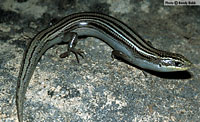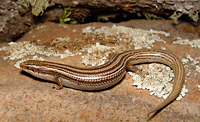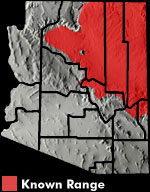Online Field Guide to The Reptiles and Amphibians of Arizona


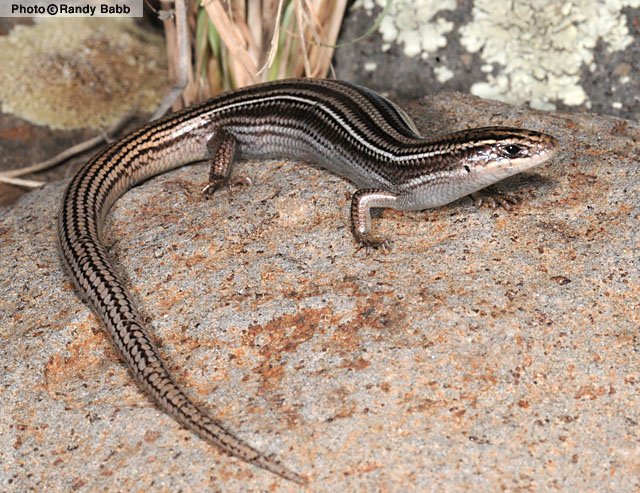
Coconino County, AZ
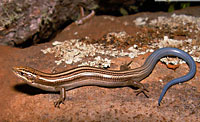 Juvenile. Coconino Co., AZ |
| MANY-LINED SKINK Plestiodon multivirgatus | |
|
DESCRIPTION: A small (up to 76 mm or 3″ from snout to vent), shiny lizard with a very long, thick tail (when not regenerated), a stout body, and small limbs. The neck is thick and the head is small. Coloration is tan, cream, gray-brown, or olive gray. Markings consist of a thin, pale stripe on each upper side and numerous alternating brown and olive gray stripes on the back and lower sides. Stripes may be muted or absent on some specimens. The underside is cream or gray. Young are darker and have a bright blue tail. Some males develop red or orange coloration on the lips during breeding season. The scales are large, rounded, smooth, and very shiny. Its numerous stripes and very long tail (up to twice the length of the body when not regenerated) distinguish this lizard from other skinks in Arizona. HABITAT: In our state this lizard is found in Plains and Great Basin Grassland, Great Basin Conifer Woodland, and Petran Montane Conifer Forest communities. It inhabits moist open prairies, wooded foothills, sunny areas on forested slopes, and rugged canyon bottoms. It is most frequently found under rocks, logs, and other surface cover. BEHAVIOR: This ground-dweller is active during the day but most activity occurs under surface cover or on moist overcast days. When spotted it can be quite difficult to capture as it quickly slides and zigzags through the grass, rocks, or surface debris. It is capable of casting off (and regenerating) the tail. Pursuers and predators often end up with nothing but a wiggling tail. DIET: The Many-lined Skink feeds on ant larvae and probably a variety of other insects. REPRODUCTION: Eggs are laid in shallow nests that are usually excavated from moist soil under logs, rocks, or other surface cover. Clutch size ranges from 3 to 9 eggs. The female remains in the nest with the eggs to guard them. By Thomas C. Brennan Brennan, T. C., & A. T. Holycross. 2006. A Field Guide to Amphibians and Reptiles in Arizona. Arizona Game and Fish Department. Phoenix, AZ Degenhardt, W. G., Painter, C. W., and Price, A. H.. 1996. Amphibians and Reptiles of New Mexico. University of New Mexico Press. Albuquerque. Stebbins, R.C. 2003. A Field Guide to Western Reptiles and Amphibians, Third Edition. Houghton Mifflin Company, Boston, MA. |
|
Visit Partners in Amphibian and Reptile Conservation:


HOME
Copyright © 2023, Arizona Game and Fish Department. All rights reserved.
If you make use of the textual contents of this site in reports, publications, etc. please cite and credit the author(s) and photographer(s). All photos on this website are copyrighted. However, those found in the species account section may be used for any noncommercial scientific, educational, or conservation purposes provided that photographs are not altered and continue to bear the copyright symbol and name of the photographer. Please contact the photographer regarding commercial use of copyrighted photographs.










